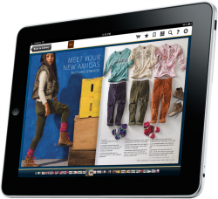 It was, by all estimates, a big year for gifting the Apple iPad 2 tablet, with analysts predicting fourth-quarter sales of 13.5 million units. That’s up 84% over the sales of the original iPad in the same quarter 2010. Besides being a boon for Apple, that constitutes good news for Catalog Spree, one of several free apps that let retailers mount digital catalogs onto tablet devices.
It was, by all estimates, a big year for gifting the Apple iPad 2 tablet, with analysts predicting fourth-quarter sales of 13.5 million units. That’s up 84% over the sales of the original iPad in the same quarter 2010. Besides being a boon for Apple, that constitutes good news for Catalog Spree, one of several free apps that let retailers mount digital catalogs onto tablet devices.
The iPad-only Catalog Spree app has been one of the highest-rated shopping applications in the iTunes Store since its general launch in April 2011, says Joaquin Ruiz, CEO of parent company Padopolis. Now the app is ranked among the most downloaded shopping utilities for the iPad—“just above Zappos and right below Groupon,” Ruiz says. In fact, in early December TV host Ellen DeGeneres named Catalog Spree the top tablet shopping app during her “12 Giveaways of Christmas” promotion—and gave her audience iPad 2 tablets with the Catalog Spree app preloaded.
That popularity also works to benefit the150 retail brands who now offer catalogs on the platform, says Ruiz, since app users tend to spend more (and more measureable) time with tablet catalogs than they do with either paper ones or catalogs digitized and translated to the PC browser screen.
“When we started, our data showed that users were viewing 40 to 50 catalog pages viewed per session and an average session time of 14 minutes,” he says. “By October we grew to 95 pages per session on average, and each session was over 25 minutes.” While data for the tail end of the year is not complete, those average views and sessions are expected to have grown.
Measurability is one large advantage to placing a catalog within an app such as Catalog Spree’s. “Every action you take inside the application is recorded anonymously,” says Ruiz. “We know how many pages you flipped, how long you stayed on a page, if you touched any of the items on the page [popping up a product photo and description], if you watched a video on a page, if you shared it on Facebook, and if you clicked through to the retailer’s web site to get more information or to complete a transaction. We see all of that.” (Actual transactions are accomplished on the retailer’s site, but the app can see what has taken place.)
Those metrics can produce some interesting shopper insights, especially when combined with other demographic information such as location. For example, Padopolis has found that users who live 100 miles or more from a major metro area tend to spend about 25% more time inside the location than the average Catalog Spree user.
“It’s not obvious until you think about it, but if you live in Fairfield CT you don’t have New York’s Fifth Avenue to walk down,” he says. “So you’ll take that walk virtually on the iPad.”
One reason Padopolis was attracted to the catalog space, in fact, was that while they are highly engaging vehicles, encouraging browsing and aspiration rather than just search-and-buy behavior, conventional paper catalogs suffer from gaps in the hard data about their usage and their role in the buying decision.”Apart from mail order or phone-in orders, the only way you can attribute sales to a catalog is to check how many people buy either in-store or through an ecommerce site using the same address you sent the catalog to,” says Ruiz.
On the other hand, Padopolis can share metrics that tell retailers which items in their catalogs are getting the highest engagement and where that interest fails to result in clickthroughs to the web site. “We can say, ‘Yes, you’re getting this item favorite lots of times, but no one’s clicking through, so is the price too high?” says Ruiz.
Retailers are also able to change their Catalog Spree catalogs in mid-season to reflect changes in product mix or merchandising strategy, swapping out products or revising whole pages. JC Penney did that during the most recent holiday season—“something you could never consider with a printed catalog.”
Padopolis started out with about seven catalog providers at launch but now has grown that number to more than 150, including JC Penney, Sears, Coldwater Creek, Red Envelope, Dooney & Bourke, Chico’s and Nordstrom (which also offers its own iPad catalog app.) For the full range of these retailers, the Catalog Spree app now accounts for 15% to 38% of the iPad traffic on their web sites, according to Ruiz.
“Since iPad traffic stays longer on those sites, converts at a higher rate and buys more, we’re responsible for a large portion of their most valuable visits,” he says. For the small to mid-sized retailers—names such as Magic Cabin, Bra Smyth and Uniform City—around 60% to 70% of that traffic is first-time visitors, turning those brands’ catalogs into prospecting tools for much less than they would spend to do the same with printed books.
Whether it’s the app or the iPad device, Catalog Spree sees its heaviest traffic on Sundays, the day of relaxation. And that held true during the holiday period too: Users opened the app more on the Sunday after Thanksgiving (Ruiz calls it “Sofa Sunday”) than on either Black Friday or Cyber Monday. “We saw about a 70% traffic spike on that day, and an overall traffic increase of about 50% for the whole month of December.”
While the company’s servers were prepared to shoulder that load, Ruiz admits that it was “just on the cusp” of being ready for the traffic influx resulting from the DeGeneres promotion on December 1, even though they knew she’s be making the Catalog Spree endorsement. “Every time there was a commercial break in that Dec. 1 show, across all the U.S. times zones, we saw this huge spike in logins to the app by people who already had it downloaded,” he says. The connection also gave a big boost to the app downloads on iTunes.
To introduce a charitable element to holiday spending, Padopolis piggybacked a 5% donation onto the Dec. 16 Free Shipping Day promotion, promising to give 5% of all sales on that day attributable to Catalog Spree as a donation to Heifer International, the program that gives livestock, seeds and agricultural training to poor families in more than 50 countries. Padopolis also conducted a “Twitterview” live interview with Heifer officials about their group’s mission at #Shop4Good on the morning of the promotion. Heifer International operates a catalog contained on the app, as do other non-profit groups.
If Padopolis faces one issue with the app, it’s retailer discovery; 150 brands, many with catalog versions for specific products, mean that the user can be faced with a bewildering array of book offerings when the app opens. Users can sort those catalogs by name, newness or the most recently viewed. But getting found can still be a challenge within the app. The company has recently hired on several digital experts to work on that problem and other user experience pain points, including Claudia Carpenter, who spearheaded the development of Google Docs, the company’s web-based work suite.
Ironically, Google launched its own tablet catalog app last August, first on its proprietary Android platform but eventually extending it to the iPad.v



